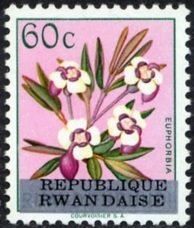Stamp: RW-U 180 (Ruanda-Urundi) overprint "REPUBLIQUE RWANDAISE" (Rwanda 1963)
RW-U 180 (Ruanda-Urundi) overprint "REPUBLIQUE RWANDAISE" (Rwanda 1963)
21 March (Rwanda ) within release Flowers with overprint goes into circulation Stamp RW-U 180 (Ruanda-Urundi) overprint "REPUBLIQUE RWANDAISE" face value 60 Rwanda santime
| Stamp RW-U 180 (Ruanda-Urundi) overprint "REPUBLIQUE RWANDAISE" in catalogues | |
|---|---|
| Michel: | Mi:RW 15 |
| Belgium: | Bel:RW 15 |
Stamp is vertical format.
silver colored beam - EuphorbiaAlso in the issue Flowers with overprint:
- Stamp - RW-U 180 (Ruanda-Urundi) overprint "REPUBLIQUE RWANDAISE" face value 25;
- Stamp - RW-U 180 (Ruanda-Urundi) overprint "REPUBLIQUE RWANDAISE" face value 40;
- Stamp - RW-U 180 (Ruanda-Urundi) overprint "REPUBLIQUE RWANDAISE" face value 60;
- Stamp - RW-U 180 (Ruanda-Urundi) overprint "REPUBLIQUE RWANDAISE" face value 1.25;
- Stamp - RW-U 180 (Ruanda-Urundi) overprint "REPUBLIQUE RWANDAISE" face value 1.50;
- Stamp - RW-U 180 (Ruanda-Urundi) overprint "REPUBLIQUE RWANDAISE" face value 2;
- Stamp - RW-U 180 (Ruanda-Urundi) overprint "REPUBLIQUE RWANDAISE" face value 4;
- Stamp - RW-U 180 (Ruanda-Urundi) overprint "REPUBLIQUE RWANDAISE" face value 5;
- Stamp - RW-U 180 (Ruanda-Urundi) overprint "REPUBLIQUE RWANDAISE" face value 7;
- Stamp - RW-U 180 (Ruanda-Urundi) overprint "REPUBLIQUE RWANDAISE" face value 10;
Stamp RW-U 180 (Ruanda-Urundi) overprint "REPUBLIQUE RWANDAISE" it reflects the thematic directions:
A flower, sometimes known as a bloom or blossom, is the reproductive structure found in plants that are floral (plants of the division Magnoliophyta, also called angiosperms). The biological function of a flower is to effect reproduction, usually by providing a mechanism for the union of sperm with eggs. Flowers may facilitate outcrossing (fusion of sperm and eggs from different individuals in a population) or allow selfing (fusion of sperm and egg from the same flower). Some flowers produce diaspores without fertilization (parthenocarpy). Flowers contain sporangia and are the site where gametophytes develop. Many flowers have evolved to be attractive to animals, so as to cause them to be vectors for the transfer of pollen. After fertilization, the ovary of the flower develops into fruit containing seeds. In addition to facilitating the reproduction of flowering plants, flowers have long been admired and used by humans to beautify their environment, and also as objects of romance, ritual, religion, medicine and as a source of food.

